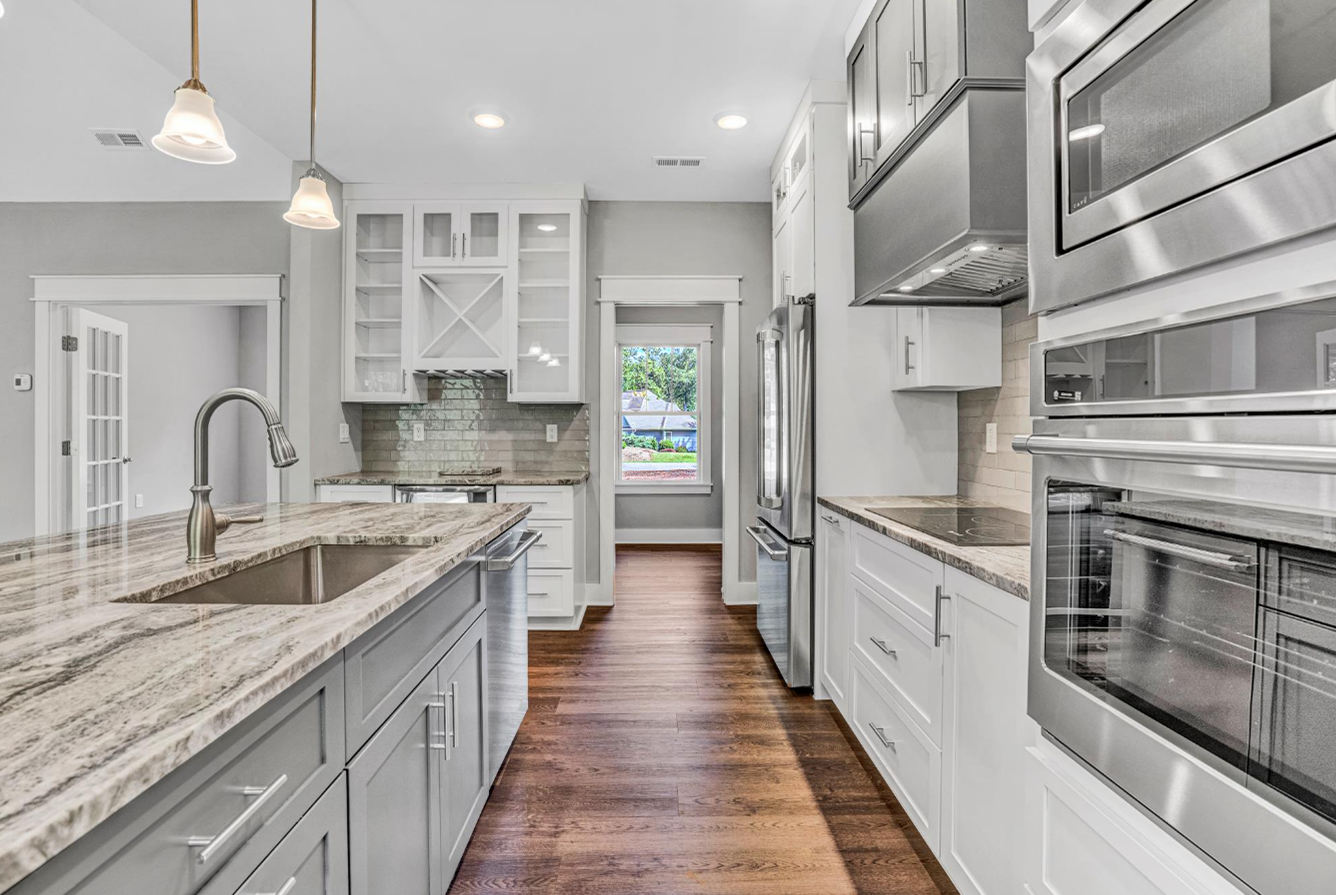Granite Countertops: What You Need to Know Before Building Your Home
In a custom kitchen, countertops do more than look good: they take the hits of daily life. That’s why Ellis Custom Homes includes granite countertops as standard throughout every home we build in Virginia, in kitchens and bathrooms. They’re beautiful on day one and still beautiful in year twenty.
See Our Complete SpecificationsWhat Granite Is (and Why It’s Great for Active Kitchens)
Granite is an igneous rock formed deep in the earth’s crust over millions of years. When magma cools slowly underground, it creates the distinctive speckled pattern of interlocking crystals we recognize as granite. Those sparkly bits? They’re primarily quartz, feldspar, and mica, along with other minerals that give each slab its unique character.
Unlike manufactured surfaces, no two granite slabs are identical. The geological conditions where the granite formed — temperature, pressure, mineral composition — create patterns and colors that are literally one-of-a-kind. This means your kitchen island will have veining and crystal formations that exist nowhere else on earth.
For active families, granite handles the reality of daily life. Hot pans from the oven, kids doing homework at the island, holiday meal prep – granite takes it all without showing wear.
Where Granite Comes From (Global Sources, Local Fabrication)
Most granite used in American homes comes from quarries around the world. Brazil and India are major suppliers, known for producing stunning varieties like Ubatuba (deep green with gold flecks) and Kashmir White (creamy background with burgundy and gray veining). Domestic sources include quarries in Vermont, Georgia, and South Dakota.
The journey from quarry to your kitchen starts with massive blocks — sometimes weighing 20 tons or more — extracted using diamond wire saws and controlled blasting techniques. These blocks are shipped to fabrication facilities where they’re sliced into slabs, typically 3/4 inch or 1 1/4 inch thick.
Our Trusted Partner: Spectrum Stone Designs
We source all our granite through our trusted partner, Spectrum Stone Designs, one of Central Virginia’s leading fabricators of natural stone countertops.
What sets Spectrum Stone Designs apart is their comprehensive three-step process: expert measurement, perfect selection assistance, and flawless installation. When you build with Ellis Custom Homes, you can even hand-select your actual slab if you wish, and see exactly what will go into your home, not just choose from samples or photos.
From Slab to Countertop: The Fabrication Process
Understanding how granite goes from raw slab to finished countertop helps you ask better questions when choosing your material and fabricator.
What Defines Premium Granite (5 Quality Markers)
Not all granite is created equal. Here’s what separates premium granite from budget alternatives.
-
Thickness Matters
While 3/4 inch granite costs less, 1¼ inch offers better durability and requires no plywood backing. The extra thickness also allows for more sophisticated edge treatments.
-
Consistent Grade
Granite is typically graded from commercial grade (thinner, more variation) to premium grade (consistent thickness, minimal imperfections). Higher grades cost more but deliver better long-term performance.
-
Color and Pattern Consistency
Quality granite shows consistent coloration throughout the slab without dramatic variations that could look patchy in your kitchen.
-
Minimal Surface Imperfections
Small surface holes (pits) are natural in granite, but excessive pitting can trap food and bacteria. Quality slabs have minimal surface imperfections.
-
Professional Sealing
Granite is naturally porous and requires sealing to prevent stains. Quality fabricators apply professional-grade sealers and provide maintenance instructions.
Installation Day in Your New Ellis Home (What to Expect)
Professional granite installation is typically a one-day process, but it requires precision and experience.
Cabinet Preparation: Your cabinets must be perfectly level and capable of supporting the weight. Granite weighs about 20 pounds per square foot, so proper cabinet construction is crucial.
Dry Fit: Before any adhesive is applied, all pieces are dry-fitted to ensure perfect alignment. This is the last chance to spot any issues.
Installation: The granite is carefully positioned and secured with construction adhesive and mechanical fasteners. Seams (if necessary) are joined using color-matched epoxy and carefully aligned for minimal visibility.
Final Details: Sink mounting, faucet installation, and cleanup complete the process. An initial sealer treatment is applied and care instructions are provided.
Care & Maintenance (Simple Routine + Water Test)
One of granite’s biggest advantages is how little maintenance it requires.
Daily Care: Warm water and mild dish soap handle most cleaning. Avoid harsh chemicals or abrasive cleaners that can dull the surface.
The Water Test: Drop water on the surface—if it beads up, your sealer is working. If it absorbs within 15 minutes, it’s time to reseal.
Resealing Schedule: Depending on the granite type and sealer quality, resealing every 1-3 years maintains stain resistance.
Heat and Stain Resistance: Granite handles hot pots and pans better than most surfaces, though trivets are recommended for very hot items. Quickly wiping up spills, especially acidic substances like wine or lemon juice, prevents any issues.
Granite vs Other Countertop Materials
| Material | Durability | Heat Resistance | Maintenance | Cost Range |
|---|---|---|---|---|
| Granite | Excellent | Excellent | Reseal every 1-3 years | Mid-range |
| Quartzite | Excellent | Excellent | Reseal every 1-2 years | Luxury |
| Quartz | Excellent | Good | Very low | Premium |
| Marble | Good | Poor | High maintenance | Premium |
| Concrete | Good | Good with sealer | Regular sealing needed | Mid-range |
| Butcher Block | Fair | Poor | Regular oiling required | Budget |
| Laminate | Fair | Poor | Low | Budget |
Why Ellis Includes Granite as Standard
After years of building custom homes in Virginia and seeing how different materials perform over time, we’ve made granite our standard for several key reasons:
Proven Durability: We see 20-year-old granite countertops that still look new. The investment pays off over decades of daily use.
Unique Character: Every installation is one-of-a-kind, giving each home natural beauty that can’t be replicated with manufactured materials.
Resale Value: Granite consistently ranks among the most desired features for Virginia homebuyers, typically adding more value than it costs.
Real-World Performance: Granite fits the way people actually live. It handles everything from holiday meal prep to homework sessions without requiring special care or constant worry about damage.
Heat and Humidity Resilience: In Virginia’s climate, with hot summers and varying humidity, granite’s natural properties make it an ideal choice that won’t warp, fade, or delaminate.
Frequently Asked Questions
1¼ inch is our standard and the better choice for several reasons. The extra thickness provides superior structural integrity, eliminating the need for plywood underlayment that 3/4 inch granite requires. This means fewer materials, cleaner installation, and better long-term performance.
1¼ inch granite also allows for more sophisticated edge treatments like bullnose, ogee, or custom profiles that simply aren’t possible with thinner material. The additional mass provides better vibration dampening, so your countertops feel more solid and substantial.
While 3/4 inch granite costs less initially, the hidden costs of additional support materials and more complex installation often narrow the price gap significantly. For the small difference in total project cost, 1¼ inch granite delivers noticeably better performance and aesthetics.
No—this is one of the most common misconceptions about granite. Most properly sealed granite only needs resealing every 1 – 3 years, and some dense granites can go even longer.
The key is understanding that different granite types have different porosity levels. Dense granites like Absolute Black or Steel Gray may only need resealing every 3 – 5 years, while more porous varieties might need attention every 12 – 18 months.
Use the simple water test: drop a few drops of water on your granite. If it beads up and stays on the surface, your sealer is working fine. If the water is absorbed within 15 minutes, it’s time to reseal. This test takes the guesswork out of maintenance scheduling.
Professional-grade sealers applied during installation typically last much longer than consumer products, which is why we ensure every installation includes proper sealing with commercial-grade materials.
This depends on your island size and granite selection, but skilled fabricators can make seams nearly invisible when they’re necessary.
Most granite slabs are approximately 9 – 10 feet long and 5-6 feet wide, so islands longer than about 8 feet will likely require a seam. However, experienced fabricators like our partners at Spectrum Stone Designs plan seam placement strategically, often locating them where they’ll be least noticeable, such as in front of a sink or cooktop.
The key to invisible seams is color matching and proper alignment. Fabricators select parts of the slab with similar patterns and use color-matched epoxy to fill the joint. When done properly, you’ll have to look carefully to spot the seam.
Some granite patterns actually hide seams better than others. Busy patterns with lots of movement mask seam lines, while solid colors or uniform patterns make seams more noticeable. This is something to discuss during slab selection.
Quality granite, properly installed, rarely develops cracks during normal use. Granite is incredibly durable – it’s the same material used in building construction and monuments that last centuries.
What homeowners sometimes mistake for cracks are usually natural fissures that were present in the original stone. These fissures are part of granite’s natural character and don’t affect structural integrity. They’re different from cracks in that they don’t go completely through the stone and aren’t sharp to the touch.
True cracks typically result from improper installation—inadequate support, uneven cabinets, or impact damage during installation. This is why choosing experienced fabricators and installers is crucial. Our partnership with Spectrum Stone Designs ensures proper installation techniques that prevent these issues.
The most vulnerable areas are around sink cutouts and overhangs, which is why proper templating and support are essential. With correct installation, granite countertops regularly last 20+ years without any cracking issues.
Absolutely. When properly sealed and cleaned, granite is actually more hygienic than many other common kitchen surfaces, including some cutting boards and butcher blocks.
Sealed granite is non-porous, which means bacteria, mold, and other contaminants can’t penetrate the surface. Regular cleaning with soap and water easily removes surface bacteria. Unlike wood or some synthetic materials, granite doesn’t develop knife cuts that can harbor bacteria.
The key is maintaining the seal and cleaning properly. Avoid harsh chemicals or abrasive cleaners that can damage the sealer. Simple dish soap and water handle daily cleaning, with occasional use of stone-specific cleaners for deeper cleaning.
Some people worry about granite’s natural radioactivity, but independent testing consistently shows that typical countertop levels are comparable to background radiation in most homes – far below any health concern thresholds established by the EPA.
Eased edges (slightly rounded) dominate current preferences for their clean, contemporary look and practical benefits. This simple profile works with both traditional and modern kitchen designs while being easy to clean and maintain.
The trend toward eased edges reflects the broader movement toward cleaner, more minimalist kitchen designs. Unlike ornate profiles, eased edges don’t collect dust or grease in detailed grooves, making them more hygienic and easier to maintain.
Bullnose edges (fully rounded) remain popular for families with small children, as they eliminate sharp corners. They’re particularly common on islands where people gather and work.
Ogee and other decorative profiles are less common now but still have their place in traditional or formal kitchen designs. These profiles can add elegance but require more careful cleaning and are more expensive to fabricate.
The choice often comes down to your kitchen’s style and how you use the space. We can show you samples of different edge profiles during the selection process to help you choose what works best for your family and design preferences.
Thinking About Building a Custom Home?
When you’re just starting to explore the idea of building a custom home, it’s natural to wonder about the countless decisions ahead. At Ellis Custom Homes, we focus on quality materials and craftsmanship that deliver lasting performance and value.
Reach Out Today
